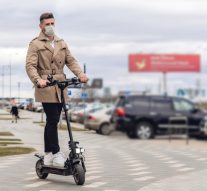
How COVID 19 is changing mobility
Energy 11 May 2020Mobility has been impacted all over the world due to the COVID 19 crisis. Public transport, micromobility, individual car commuting, all modes have seen a dramatic decrease in usage across the urban ecosystem. What is yet to be seen is how cities and their inhabitants will move in the coming days, weeks, months and years. We are starting to get a preview of what is to come, based upon innovative, sustainable, and human centric initiatives being introduced at the local and urban level.
Many cities are rapidly introducing interventions to make their streets networks less car centric, and friendlier to cyclists and pedestrians. Specifically, in cities ranging from Milan, Berlin, New York, Barcelona, Paris, and Oakland, CA, an “open streets” movement is taking root. However, the challenge at hand is how cities can ensure short term interventions such as these which emphasize active transportation can be integrated within the framework of urban planning and public infrastructure operations and investment.
The impact on various urban mobility modes is widespread. Specifically, public transport has seen declines across all modes including bus, commuter rail, metro, and tram since early March. While the current local and national plans to stage a phased reopening of the economy across Europe and North America is underway, social distancing measures are being implemented to encourage passengers back to public transport, such as spaced markings, hand sanitizers, and obligatory usage of face masks.
Micro mobility has seen an even more dramatic impact in the wake of COVID-19. For example, with approximately 99% of electric scooters deactivate/removed from cities, Lime has temporarily halted operations. But this is just the tip of the iceberg. All mobility services providers across the ecosystem (including scooters, ridehail, and carshare) have seen a dramatic reduction in demand for their shared services. While there are measures in place to be deployed across specific modes, it is yet to be seen how shared (micro) mobility will recover, and what role it will play in the landscape.
Bikesharing (and personal cycling) has been the one bright spot in the urban mobility ecosystem. With the rapid urban design interventions to promote cycling, pop up bike lanes, and other physical infrastructure improvements, urban residents have sought to maintain social distancing, without having to lose their freedom of movement. In addition, as urban bike sharing has been public subsidized in many schemes, it is better able to weather the economic storm than many of the VC-backed start-ups that quickly halted service.
The recent decrease in traffic and use of transport resulted in significant drops of air pollution and warming gasses around the world. For instance, in New York, carbon monoxide from cars was down almost 50% compared to last year. In China, the measures taken by the government led to a significant reduction of air pollution.
Forced confinement has drastically reduced the amount of passenger kilometers travelled as well as overall industrial activity. This reduced activity has resulted in dramatically cleaner air, particularly in the most polluted regions.
For instance, smog has by and large disappeared in many urban areas in China. Similarly, confinement brought NO2 levels down by 33% in Los Angeles and even 70% in Delhi. In Europe, Paris saw a 60% drop in NO2 emissions and a 20-30% improvement in air quality to reach a level never seen in the past 40 years.
People are breathing better and can enjoy clearer skies — for now. They must also be aware that these improvements are highly correlated with the absence of fuel burning vehicles: mobility must become massively electric for this exceptional improvement to be sustained. For this to happen, responsible regulators must accelerate the deployment of EVs under increasing pressure from their constituents.
We really need to rethink the role of cities and how they serve as stewards for the public good (whether it be transport, environment, public health, safety, education, economic development, etc). The reason for this is because cities can take a central role in determining their future, and setting the policies and legal frameworks for start-ups and new market entrants in the shared mobility domain to financially and operationally succeed.
In taking a more collaborative approach to integrating shared mobility options (as has been successfully done across multiple European cities), the long term sustainability of such offers can be ensured, ultimately benefiting all stakeholders in the mobility ecosystem.
A post-pandemic world has the potential to have better urban mobility options than the world before, but we need transportation leaders who make smart decisions now to get us there.


